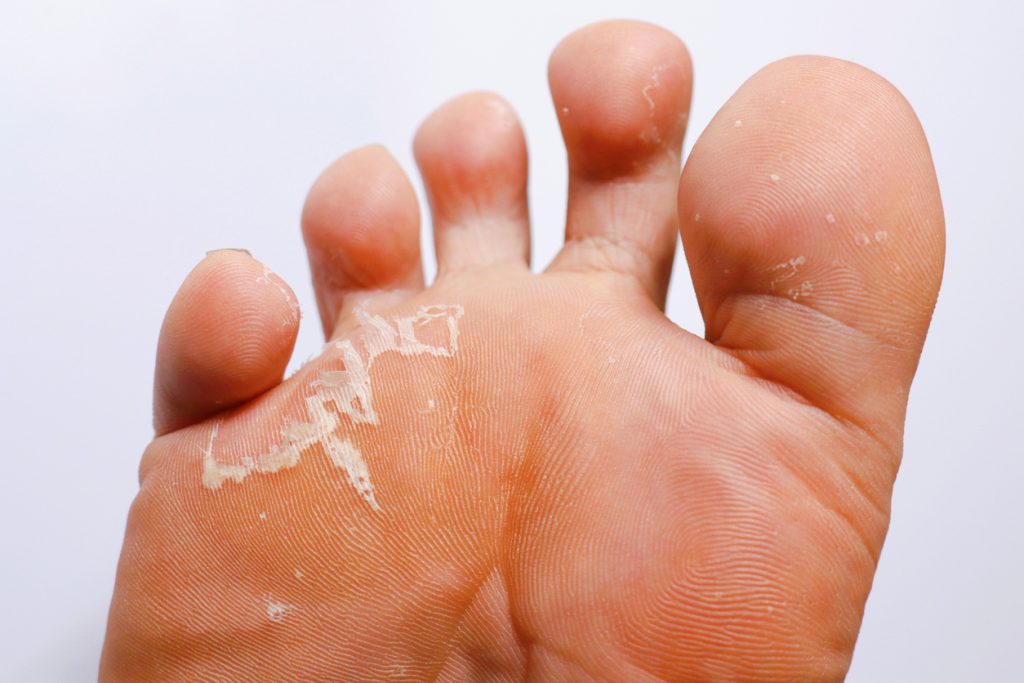Last updated: August 2023
Also known as…Tinea pedis
What is athlete's foot?
Athlete’s foot is a fungal infection affecting the skin on the feet, usually between the toes. The same fungus can also spread to the hands and toenails. The term athlete’s foot comes from the fact that the infection is commonly seen in athletes, such as runners, who shower often and have damp shoes and socks.
Who gets athlete's foot?
Athlete’s foot is more common in men and people over 60 years old.
Individuals with a weakened immune system or diabetes are more likely to develop athlete’s foot, particularly those who have a cut or open sore on their feet.
What causes athlete's foot?
Athlete’s foot occurs when the foot comes into contact with a fungus, generally from the group of fungi called dermatophytes. This can happen if the foot directly touches the fungus, either from another infected individual or a surface that has been contaminated. The fungi thrive in warm, moist environments such as locker rooms and gym showers. They feed off keratin, a protein that makes up our skin, hair and nails.
What does athlete's foot look like?
In athlete’s foot, the skin between the toes and feet is usually scaling, peeling and cracked. The skin can also have a whitish and soft appearance. In some cases, blisters can form, and ulcers can appear.
Individuals with athlete’s foot often experience itching. A burning and stinging sensation can also occur.
Some individuals can have an allergic reaction to the fungus, causing blistering of the hands or feet. Severe complications can form, such as:
- Secondary bacterial infections, causing the foot to be painful, swollen and hot.
- Bacterial infection of the skin spreading to the lymphatic system.

Figure 1. Athlete’s foot on toes

Figure 2. Athlete’s foot on sole of foot
How is athlete's foot diagnosed?
Athlete’s foot is usually diagnosed clinically. In some cases, investigations may be needed to identify the specific infection causing the athlete’s foot, such as a skin scrape test (i.e., potassium hydroxide skin test).
How is athlete's foot treated?
Treatment options will vary depending on the individual and their needs, and should begin with general measures including:
- Washing your feet, especially the space between your toes, with soap and water regularly and dry thoroughly afterwards.
- Wearing sandals in public spaces where water might touch your feet such as public showers and near swimming pools.
- Washing bed sheets, socks and towels in hot water (60°C or higher) and disinfecting shoes using wipes or sprays.
- Not sharing socks or shoes with others.
- Changing your socks when your feet become sweaty.
Athlete’s foot can be treated with over-the-counter antifungal creams, such as:
- Miconazole
- Terbinafine
- Clotrimazole
- Butenafine
- Tolnaftate
Prescription topical and oral treatments may also be used, including:
- Prescription-strength clotrimazole or miconazole
- Topical corticosteroids
- Oral antifungal medications, such as terbinafine, itraconazole, fluconazole
- Oral antibiotics
At-home treatments, such as soaking feet in salt water or diluted vinegar or applying tea tree oil to the skin infection, may be recommended.
What is the likely outcome of athlete's foot?
Athlete’s foot will generally improve and clear up if appropriately treated. However, this can vary depending on the severity of the disease.
The fungal infection can resolve quickly, but in some cases it can last for a long time. Occasionally long-term treatment may be needed to prevent the infection from reoccurring.
| Dr Niyaz Mostafa and A/Prof Stephen Shumack | August 2023 |
| Dr Niyaz Mostafa and A/Prof Stephen Shumack | February 2020 |
Disclaimer
2019 © Australasian College of Dermatologists.
You may use for personal use only. Please refer to our disclaimer.